Last updated on March 2nd, 2024 at 08:07 am
Welcome to the beautiful world of gardening. If you are a plant lover looking to expand your collection, then consider propagating pothos. Pothos plants can be easily multiplied, making it one of the best ways to grow your green family. They are known for their elegant veins and heart-shaped leaves, making them low-maintenance indoor plants that are easy to grow. That’s why pothos plants are the most popular choice for indoor gardening. It is a very easy and satisfying procedure to propagate pothos. ‘Seriously, when you start to propagate pothos at home, you won’t be able to stop.’
Different types of pothos plants can be successfully propagated by using three different methods: water, soil, and air layering. All of these are straightforward and fulfilling processes. The key difference lies in the speed of root development. Water-started plants produce roots more quickly, while the soil and air layering methods may take a little longer. I’ll explain all these ways so you can choose the one that works best for you.
Contents
Best Time To Propagate Pothos

The best time to propagate pothos is during spring and summer because both seasons have warmer temperatures and longer daylight hours. These conditions promote active plant growth, making it the ideal time to propagate pothos. In contrast, autumn and winter bring cooler temperatures and shorter days, which means providing less natural light for photosynthesis. This can slow down plant growth and root development. Pothos thrive in temperatures between 70-90°F (21-32°C), making these seasons less ideal for propagation. The photo above is courtesy of Donald Lee Pardue.
Tools And Material You’ll Need
For Propagate Pothos in Water
- Healthy Pothos Plant
- Clean, Sharp scissors or Pruning Shears
- Plastic or Glass Container/Vase
- Water
- Container or Pot with Drainage Holes
- Well-Draining Mix Soil
For Propagate Pothos in Soil
- Healthy Pothos Plant
- Clean, Sharp scissors or Pruning Shears
- Rooting hormone
- Container or Pot with Drainage Holes
- Well-Draining Mix soil
For Propagate Pothos Through Air Layering
- Healthy Pothos Plant
- Clean, Sharp scissors or Pruning Shears
- Rooting Hormone (optional)
- Sphagnum moss
- Plastic Wrap
- Strong thread
- Container or Pot with Drainage Holes
- Well-Draining Mix soil
- Plastic container
Propagate Pothos Through Water

Propagate pothos in water is a very popular and frequently used method, it’s a straightforward process. And it’s an enjoyable one! Because you can see your cuttings develop roots right before your eyes, and then smoothly transition these rooted cuttings into the soil, is very satisfying. The things you will need are your cuttings, a suitable container, and an ample supply of water.
Preparing Your Workspace
Gather everything you will need and arrange it in your workspace. This will make the process very easy and more enjoyable as a result.
Select The Parent Plant And Take Cuttings For Propagate Pothos
Choose a mature and healthy pothos plant to propagate pothos. Look for stems without any signs of damage or disease. By using sharp and clean scissors or pruning shears, make a clean cut right below a leaf node on a stem to take cuttings from the mother plant of pothos. Each cutting must have a minimum of three to four nodes. These nodes are small bumps where new leaves grow. It is from these nodes that roots will develop on the stem cuttings.
Remove the Excess Leaves
After cutting your stems, it’s a good idea to remove the leaves from the bottom. This part will be in the water, and by trimming the leaves, you’re helping the stem focus its energy on growing roots. You can either gently pull off the leaves or carefully cut them. Just make sure to leave about 2 to 3 leaves on each stem cutting. This will give your new plant the best chance to grow strong and healthy roots.
Place the Stem Cuttings in the Water
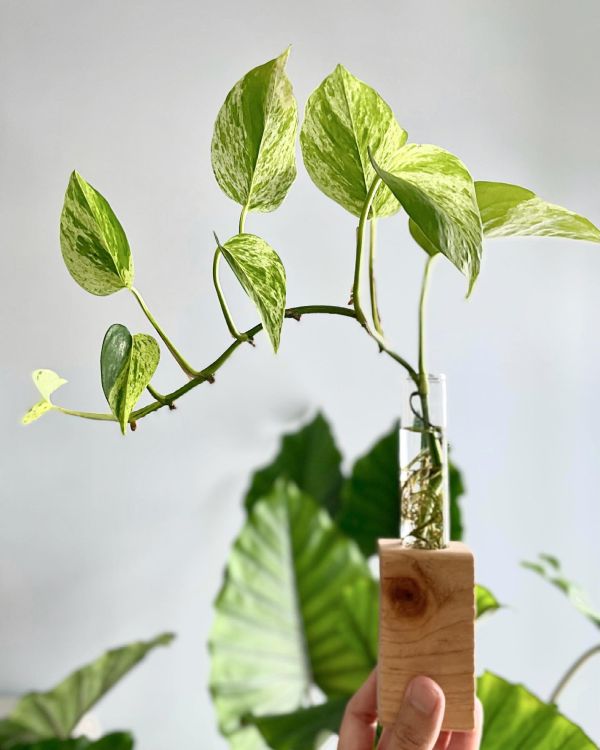
Image credit: @beautiful.therapy
For this step, you can use clear plastic containers, glass jars, or vases. Fill a clean glass or jar with enough water and place the cuttings in it. Make sure that the leaves are above the water and the part where the nodes are should be submerged. If the cuttings tend to float, you can use small rocks or pebbles to weigh them down. This helps the roots grow properly.
Provide Indirect Light

Place the container where it gets plenty of bright, indirect light. Avoid direct sunlight, as it can promote the growth of algae in the water. The photo above is courtesy of Kendra Kat.
Change the Water Occasionally
As the cuttings begin to grow, remember to keep an eye on the water level. Add more water if needed to keep the lower part of the stems underwater. Change the water every 1-2 weeks to keep it fresh. Now, just watch and wait! In a few weeks, you should start to see roots sprouting from the nodes. Initially, you’ll start to see tiny, white, hair-like roots growing from the stems.
Transplant Rooted Stem Into Soil For Propagate Pothos
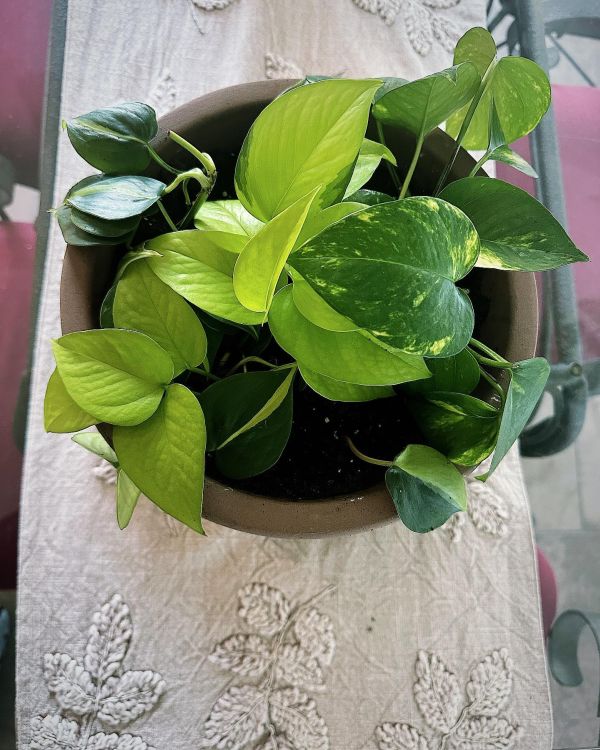
Image credit: @rondasd
When the roots are about two to three inches long, it’s time to transplant them into the soil. Choose a mixture of good soil and put it in a pot with proper drainage holes. Gently take the cuttings out of the water and plant them in the soil. Water it well and put it in a spot where it gets plenty of bright, but not direct, sunlight. Soil should be moist for 1-2 weeks, as this helps the roots adjust to their new home in the soil.
Propagate Pothos Through Soil
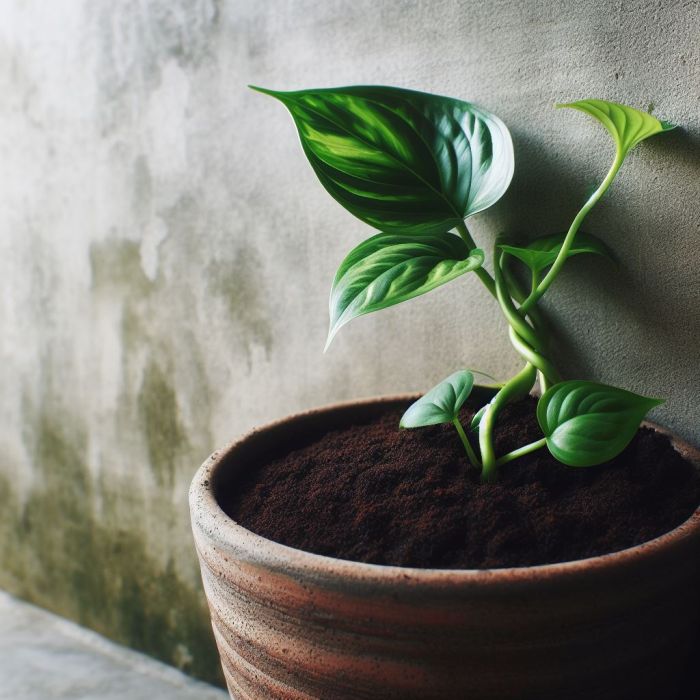
If you don’t want to propagate pothos in water, you can plant it directly in the soil. It works very well, though it’s not as commonly used. Using rooting hormone is a good idea for this approach. The things you will need are your cuttings, a pot or container with drainage holes, and a good mixture of soil and rooting hormone.
Preparing Your Workspace
Gather everything you will need and arrange it in your workspace. This will make the process easier and more enjoyable as a result.
Select The Parent Plant And Take Cuttings For Propagating Pothos
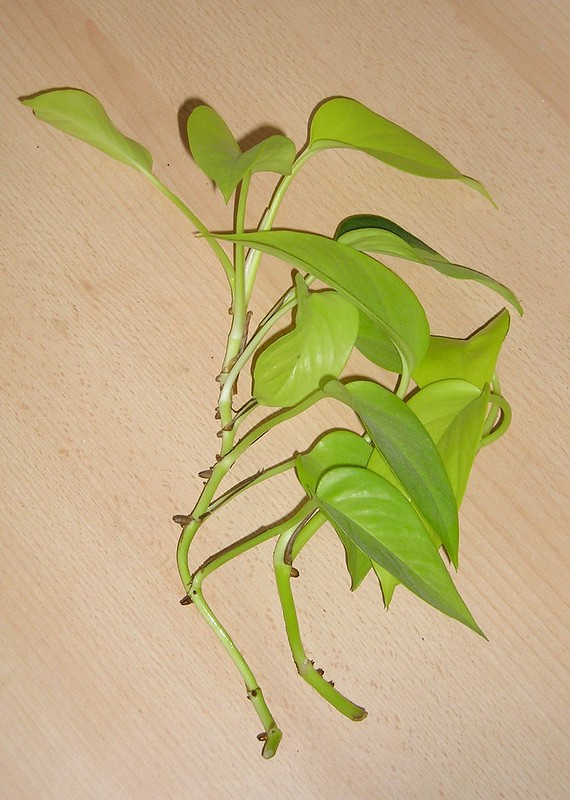
Choose a mature and healthy pothos plant to propagate pothos. Look for stems without any signs of damage or disease. By using sharp and clean scissors or pruning shears, make a clean cut right below a leaf node on a stem to take cuttings from the mother plant of pothos. Each cutting must have a minimum of three to four nodes. These nodes are small bumps from which the leaves grow. It is from these nodes that roots will develop on the stem cuttings. The photo above is courtesy of Maja Dumat.
Remove the Excess Leaves
After cutting your stems, it’s a good idea to remove the leaves from the bottom. You can either gently pull off the leaves or carefully cut them. Just make sure to leave about 2 to 3 leaves on each stem cutting. This will give your new plant the best chance to grow strong and healthy roots.
Dip the Stem Cutting in Root Hormone
Place one end of the stem cutting in rooting hormone powder, as it helps the roots grow faster.
Planting The Cutting In Soil
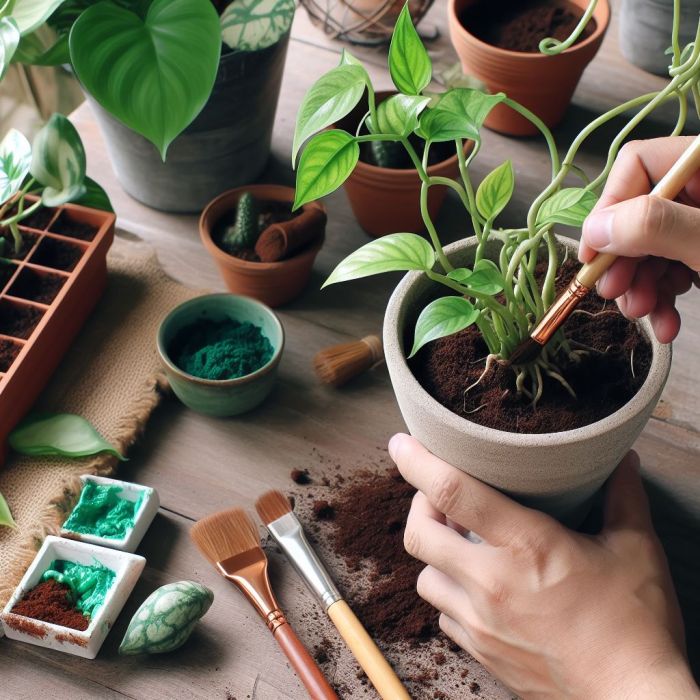
Fill pots or containers with a good mixture of soil. The pots or containers should have small holes at the bottom. Make a small hole in the soil with your finger or a stick, gently put the cutting (that you dipped in the rooting hormone) in the hole, and push the cutting down so the nodes are covered by soil, but the leaves along the stem are still above the soil.
Soil Should Be Moist
Put the pots in a place where there is bright but not direct sunlight. Avoid direct sunlight as it can be harmful to young plants. Make sure the soil stays a little damp, but not too wet because the cuttings are developing roots. After two weeks, you can start leaving the soil to dry out a bit between waterings.
Propagate Pothos through Air Layering
Lastly, pothos can be easily propagated through air layering. If the first two methods don’t work for you, you can give air layering a shot. But keep in mind, propagating pothos by using water or soil method is much easier. Air layering is a method that is used to root a part of a mature pothos plant while it is still connected to the main plant.
Preparing Your Workspace
Gather everything you will need and arrange it in your workspace. This will make the process easier and more enjoyable as a result.
Select The Parent Plant And Make A Cut
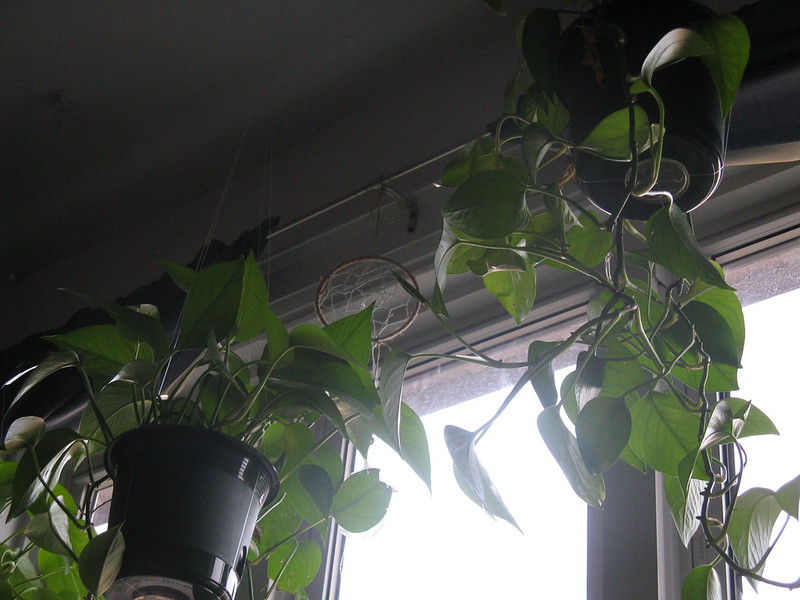
Choose a mature and healthy pothos plant. Look for stems without any signs of damage or disease. By using sharp and clean scissors or pruning shears, make a clean cut about 12-18 inches from the tip, and then make a 1-2 inch horizontal cut around the stem. The cutting area of the stem must have nodes. These nodes are small bumps from which the leaves grow. It is from these nodes that roots will develop on the stem cuttings. The photo above is courtesy of Helena Jacoba.
Applying Rooting Hormone
Dust the cutting area of the stem with rooting hormone to encourage root growth. Applying rooting hormone to the cutting is an optional step for speedy growth of the roots.
Wrapping With Sphagnum Moss
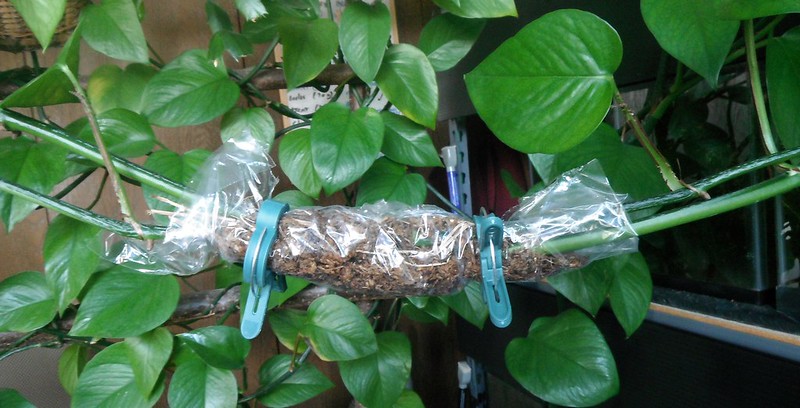
After applying the rooting hormone, wrap the cut section with moist sphagnum moss. To retain moisture, thoroughly wrap it with plastic. The photo above is courtesy of Storm.
Securing and Waiting For Roots
Wrap the plastic-covered section with strong thread to hold it in place. After securing it tightly, leave it for a few weeks for the roots to grow.
Cutting The Rooted Stem
After a few weeks, roots will grow. Once the roots are established and about two to three inches long, carefully cut the rooted stem from the mother plant using a pair of sharp and sterilized hand pruners or scissors.
Plant the Rooted Stem in The Soil
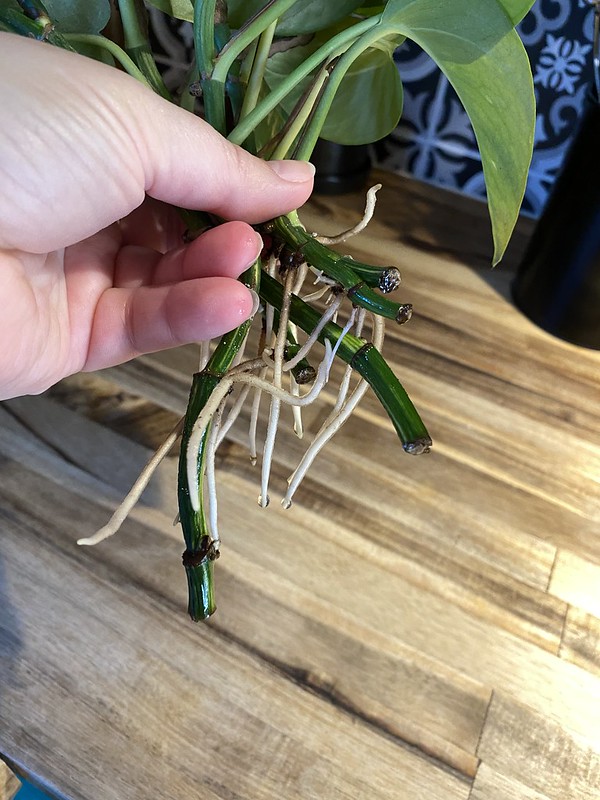
Once the roots are about two to three inches long, this will likely take a few weeks but could take over a month. You can transplant them into the soil. Use a well-draining soil mixture with drainage holes. Gently remove the cuttings from the water and plant them in the soil. Give fresh Water thoroughly and put it in a location with bright, indirect light. Soil should be evenly moist for one to two weeks in starting to help the roots adjust to the soil. The photo above is courtesy of evetrombley.
FAQs
Is the rooting hormone necessary for these methods?
Rooting hormone is just optional to speed up the rooting process. It’s especially beneficial for more challenging or stubborn cuttings.
Can pothos propagate permanently in water after the rooting process?
Yes, pothos can be sustained in water after the rooting process. But it’s important to change the water every week to provide essential nutrients.
Can pothos propagate with no sunlight?
The pothos is very tough and among the best indoor plants for dark rooms. One of the plants that don’t need sun to grow.
Which common mistakes should be avoided when propagating pothos?
Overwatering, using unsuitable soil, and direct sunlight are common mistakes. Moreover being impatient and disturbing the cuttings can slow down the propagation process.
Propagate pothos allows you to expand your green family easily. Whether you choose the water, soil, or air layering method, each approach has its own simplicity and charm. Keep in mind that patience is key. Observing your pothos cuttings grow roots and transform into lush plants is a truly satisfying experience. As you gain confidence in propagating, you may find yourself with a growing collection of these low-maintenance beauties.


7 thoughts on “3 Simple Methods to Propagate Pothos”